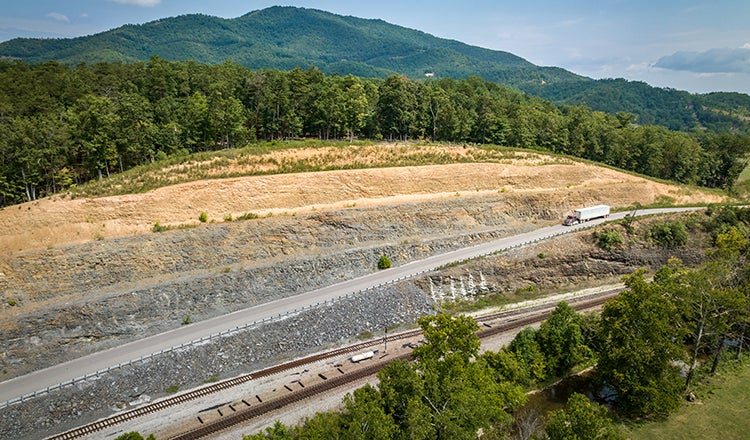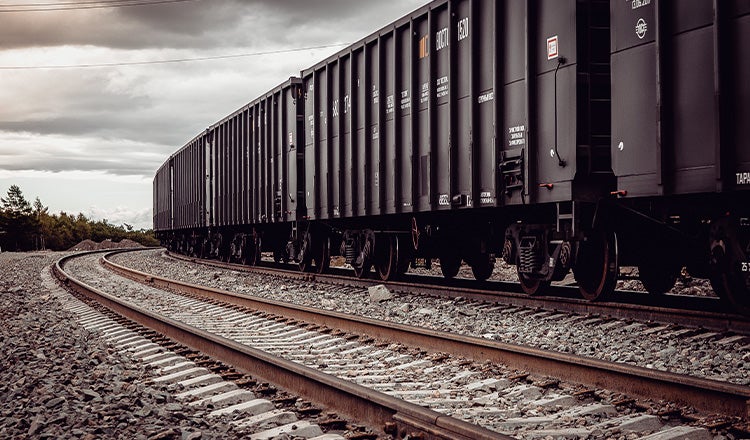
Getting on Track with Industrial Rail: What to Know Before Planning Your Facility
As rail trends upward as a cost-effective, environmentally friendly and sustainable option for transporting goods and materials across North America, our experts are seeing more industrial facilities interested in adding or expanding their rail capabilities.
We turned to our experts for their advice when considering rail at industrial facilities. Here are some things to know.
The Benefits of Rail
Clients are looking for a secondary mode of transportation that is efficient moving materials but also beneficial for costs, sustainability and overall labor efficiency. Add truck driver shortages and the high cost of diesel fuel, and that reduces the distance needed for rail transport to become a feasible alternative to trucks.
We are also seeing a push toward sustainability. Rail has environmental benefits with relatively low energy use and emissions. According to the Association of American Railroads, moving freight by rail instead of trucks lowers greenhouse gas emissions by up to 75%, on average. That can help our clients meet sustainability goals and metrics for grant funding opportunities in the United States.
The Association of American Railroads points out freight railroads are among the safest way to move goods over land. Virtually every aspect of rail operations is subject to safety oversight by the Federal Railroad Administration. Railroads are also subject to oversight by the Occupational Safety and Health Administration, the Pipeline and Hazardous Materials Safety Administration and the Department of Homeland Security.
The 101 of Working With Railroads
Railroads are highly regulated and safety focused, which means a more cautious approach to new projects. There are standards that must be considered from the very beginning — think geometry (curve and grades), clearances and capacities — and it’s a balance to find what’s economical for clients while adhering to requirements. That can sometimes be a deal-breaker, as the expense doesn’t always make sense. That’s why being informed about railroad standards early in planning, well before any engineering, is critical.
Industrial clients must remember each scenario is different. What works at one location, with one railroad, or with one type of business may not work elsewhere. The experience can also be different when working with short-line railroads versus Class I railroads — the largest railroads in the United States — as each have different operational and infrastructure requirements.
Good consultants know the right balance when suggesting deviations from standards. To expedite the process, engage the railroad inside its own process. Approvals or statements outside of those official processes don’t hold up and can cause delays. Expect the entire process to take months based on the guidelines outlined by the railroads.

What Industrial Facility Owners Should Consider When Rail Planning
Before planning a new or upgraded industrial facility, and certainly before new site or land acquisition, owners and developers should carefully consider if rail logistics are needed, either now or in the future. Adding rail to an industrial site is not always as simple as adding a new track to load or unload goods. We advise our clients to consider many factors, including:
- Rail network connectivity
- Track geometry and configuration for efficient operations and railroad standards
- Potential rail operating plans and logistics strategies for efficient interchange and switching operations
- Track and railcar storage capacity requirements
- Operational and material handling processes
If using a consultant, railroads also want assurance the team understands rail operations, engineering and design principles, especially those required as part of the overall industrial development process. Using a respected firm like ours provides confidence to railroads throughout project development and can result in a smoother, and often shorter, project development process from concept to construction.
Qualities of a Good Rail and Industrial Facility Consultant
First, the industrial facility owner or developer must be involved. Consultants can only assist. The railroad has the ongoing relationship with the owner — not the consultant.
That said, railroads have an industrial development process for new or existing customers to follow. Being familiar with it from project start is key. Start discussions with the serving railroad carrier early and bring your rail consultant to the table. Railroads want to know if there is a rail consultant selected and under contract. They do not want an engineer or consultant without specific rail experience. In fact, Union Pacific Railroad lists seven qualified engineering firms that must be involved when a consultant is brought in, either in a direct consultancy role or overseeing the work. We are one of those seven accepted firms.
A good consultant accounts for your project’s possible conditions and discusses them with you. From the start, they consider:
- Desired rail operations of the serving carrier
- Topography
- Drainage
- Environmental conditions
- Utilities (and their conflicts)
- Rules of thumb for capacities
- Long-term efficiency
- Possible expansion for growth
- Main track occupancy to maintain rail corridor fluidity (especially on high-volume rail corridors and/or those with regular passenger train service)

The Impact of Environmental Issues and Permitting
There’s more to consider than avoiding a wetland or stream, although those are important aspects. An upfront assessment of permitting requirements and risks is critical in avoiding downstream issues that might halt a project.
With a continuing focus on safety, industrial facilities need to consider the transport of hazardous raw materials and products and the associated safety risks. Rail is among the safest modes of ground transportation, but sometimes public perception does not align. Communication with the public is necessary to meet permitting timelines and avoid project roadblocks.
Rail can also help industrial facilities meet corporate and government sustainability goals by decreasing energy use and reducing greenhouse gas emissions. This is especially true as locomotive technology continues to improve fuel efficiency or transitions to other energy sources, such as renewable fuels, battery and electric, and hydrogen.
While the rail network is expansive, industrial facilities may require capacity improvements, such as new sidings or yard expansion. While considering these potential rail network expansions, railroad owners will consider overall operations. However, it’s important to also consider long-term effects on environmental resources, potential requirements for mitigation and associated costs, and the increasing focus from the regulatory community and public on minimizing and avoiding environmental impacts.
Environmental impacts include a variety of areas such as wetlands, noise, air quality, resiliency and climate change, and environmental justice. Each project team must work collectively to balance the environmental impacts with the project needs to create a viable project in the eyes of the regulatory community and public.
Considering What’s Outside Your Facility’s Fence
For a new facility considering rail transport, select a site that provides access by more than one railroad. This means direct service from two or more rail carriers, but it also means commercial access to more than one railroad, creating service, pricing and commercial benefits. Having a well-informed consultant that knows the rail network and commercial agreements can be a huge addition.
You should understand your proposed volumes (inbound and outbound), impacts and variability to the whole supply chain (not just your own), what markets you can gain access to via rail, railcar fleet strategy and sizing, and whether you’re a unit train or manifest customer. Keep in mind, the railroad has capacity constraints on its own system and wants to accommodate you, but your capacity must fall in line with its requirements.
Locating on a branch line or low-density industrial spur may result in reduced service frequency unless there are other businesses on the line to bring regular service. On the flip side, building on a high-density mainline, especially those with frequent passenger service, may result in high costs for the railroad to clear its busy mainline operations while servicing your site.
We offer modeling and logistics workshops to explore client wish lists and cost-effective plans to meet their rail logistics needs. This may be as simple as accommodating some resiliency and buffer into the rail footprint. Or it could be developing full-fledged supply chain studies and models to test different volume scenarios, supply chain outages, and other potential variables as part of overall rail logistics and site operations. This can be valuable not only in the planning and development stage, but also during ongoing operations.
In conclusion, industrial facility owners should consider the whole facility when contemplating rail upgrades or additions and understand railroads are engaged to help you with your project. Each project will have unique requirements and considerations. Engaging a well-qualified and experienced rail consultant like us can help you through the process.




